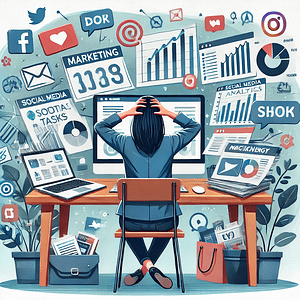Marketing isn’t a one-time activity or a quick fix; it’s an ongoing engine that, when built correctly, powers your business’s growth year after year. For business owners and decision-makers, the challenge lies in creating a marketing strategy that delivers consistent results, not just short-term wins.
Here’s how to build a marketing engine that works and keeps working for the long haul.
1. Create a Repeatable Process
The first step in building a sustainable marketing engine is to develop a repeatable process that can be executed consistently. This means outlining clear steps and workflows for each part of your marketing strategy—from lead generation to nurturing prospects to converting leads into customers.
- Define your target audience: Clearly identify who you’re marketing to and understand their needs and pain points.
- Develop your value proposition: What sets your business apart? This needs to be communicated consistently across all marketing materials.
- Create content consistently: Content is the fuel for your marketing engine. A survey from Demand Gen found that 47% of buyers engage with 3-5 pieces of content before engaging with a sales rep . Establish a content calendar that ensures you’re continuously delivering valuable information to your audience.
Pro Tip:
Use automation tools to streamline repetitive tasks such as social media scheduling, email marketing, and lead nurturing.
According to a report by Invesp, marketing automation can increase conversion rates by up to 77% .
2. Focus on Measuring Success
Once you have a process in place, the next step is to measure the effectiveness of your efforts. Without proper tracking, you won’t know what’s working and what needs improvement.
- Set Key Performance Indicators (KPIs): These should be specific, measurable goals that reflect the performance of your marketing engine. KPIs could include metrics like website traffic, conversion rates, and cost per lead.
- Use Analytics Tools: Google Analytics, HubSpot, or other marketing platforms allow you to track your performance in real time. Research from McKinsey shows that companies that integrate data and analytics into their operations see a 23x increase in customer acquisition rates.
Pro Tip:
A/B testing can help you refine your strategies. Test variations of your content, CTAs, and landing pages to see what resonates best with your audience.
3. Continuously Optimize
Marketing is never static. As you track your results, continuously tweak and optimize your approach to maximize efficiency and effectiveness. This might mean reallocating budget, refining your messaging, or trying new channels.
- Stay Agile: The marketing landscape changes rapidly. According to Gartner, 87% of senior business leaders say digitalization is a top priority . Keep your marketing engine adaptable so you can pivot quickly when new trends or platforms emerge.
- Optimize for ROI: Don’t spread your resources too thin. Focus on the marketing tactics that deliver the highest returns. For instance, if email marketing consistently drives conversions, allocate more budget and resources there.
Pro Tip:
Regularly update your content and SEO strategy to reflect changes in search engine algorithms and consumer behavior. According to BrightEdge, organic search is responsible for 53% of all website traffic.
4. Nurture Leads with a Strong Follow-Up Process
Generating leads is just the beginning. A strong follow-up process ensures that these leads convert into loyal customers. Use automated email sequences, retargeting ads, and personalized outreach to stay top of mind and move leads through your sales funnel.
- Segment your audience: Tailor your follow-up efforts based on where leads are in the customer journey.
- Use CRM tools: Implement a CRM system that helps track and manage your interactions with prospects and customers. Data from Salesforce suggests that CRM systems can improve sales by up to 29%.
Build, Measure, Improve—Repeat
A successful marketing engine requires constant fine-tuning. By establishing a repeatable process, regularly measuring your results, and optimizing your efforts, you can create a marketing engine that consistently drives growth.





